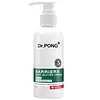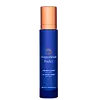What's inside
What's inside
 Key Ingredients
Key Ingredients

 Benefits
Benefits

 Concerns
Concerns

 Ingredients Side-by-side
Ingredients Side-by-side

Water
Skin ConditioningUrea
BufferingGlycerin
HumectantTalc
AbrasiveCaprylic/Capric Triglyceride
MaskingSimmondsia Chinensis Seed Oil
EmollientCetyl Alcohol
EmollientStearyl Alcohol
EmollientGlyceryl Stearate
EmollientTocopheryl Acetate
AntioxidantPEG-100 Stearate
Butyrospermum Parkii Butter
Skin ConditioningAloe Barbadensis Leaf Juice Powder
Skin ConditioningMaltodextrin
AbsorbentButylene Glycol
HumectantSodium Lauroyl Lactylate
EmulsifyingCentella Asiatica Leaf Extract
Skin ConditioningChenopodium Quinoa Seed Extract
Skin ConditioningEucalyptus Globulus Leaf Extract
PerfumingHydrogenated Lecithin
EmulsifyingPanax Ginseng Root Extract
EmollientCholesterol
Emollient1,2-Hexanediol
Skin ConditioningCeramide NP
Skin ConditioningPhytosphingosine
Skin ConditioningCeramide AP
Skin ConditioningEthyl Hexanediol
SolventHexacarboxymethyl Dipeptide-12
HumectantCeramide EOP
Skin ConditioningTriethanolamine
BufferingCarbomer
Emulsion StabilisingAllantoin
Skin ConditioningPEG-75 Stearate
Xanthan Gum
EmulsifyingCeteth-20
CleansingSteareth-20
CleansingTriethoxycaprylylsilane
Disodium EDTA
Phenoxyethanol
PreservativeChlorphenesin
AntimicrobialWater, Urea, Glycerin, Talc, Caprylic/Capric Triglyceride, Simmondsia Chinensis Seed Oil, Cetyl Alcohol, Stearyl Alcohol, Glyceryl Stearate, Tocopheryl Acetate, PEG-100 Stearate, Butyrospermum Parkii Butter, Aloe Barbadensis Leaf Juice Powder, Maltodextrin, Butylene Glycol, Sodium Lauroyl Lactylate, Centella Asiatica Leaf Extract, Chenopodium Quinoa Seed Extract, Eucalyptus Globulus Leaf Extract, Hydrogenated Lecithin, Panax Ginseng Root Extract, Cholesterol, 1,2-Hexanediol, Ceramide NP, Phytosphingosine, Ceramide AP, Ethyl Hexanediol, Hexacarboxymethyl Dipeptide-12, Ceramide EOP, Triethanolamine, Carbomer, Allantoin, PEG-75 Stearate, Xanthan Gum, Ceteth-20, Steareth-20, Triethoxycaprylylsilane, Disodium EDTA, Phenoxyethanol, Chlorphenesin
Water
Skin ConditioningCaprylic/Capric Triglyceride
MaskingGlyceryl Stearate
EmollientGlycerin
HumectantGlyceryl Stearate Citrate
EmollientDicaprylyl Ether
EmollientPanthenol
Skin ConditioningCetearyl Alcohol
EmollientXylitylglucoside
Humectant1,2-Hexanediol
Skin ConditioningButyrospermum Parkii Butter
Skin ConditioningSilica
AbrasiveAnhydroxylitol
HumectantHelianthus Annuus Seed Oil
EmollientXylitol
HumectantTocopheryl Acetate
AntioxidantXanthan Gum
EmulsifyingBisabolol
MaskingAlcohol
AntimicrobialGlucose
HumectantO-Cymen-5-Ol
AntimicrobialBiosaccharide Gum-2
Skin ConditioningChamomilla Recutita Flower Extract
MaskingCholesterol
EmollientHydrogenated Lecithin
EmulsifyingSodium Hydroxide
BufferingTocopherol
AntioxidantAlanyl Glutamine
HumectantAloe Barbadensis Leaf Juice Powder
Skin ConditioningArginine
MaskingCeramide Ng
Skin ConditioningCeramide NP
Skin ConditioningGlycine
BufferingLysine
Skin ConditioningOleic Acid
EmollientPalmitic Acid
EmollientPhenylalanine
MaskingProline
Skin ConditioningScenedesmus Rubescens Extract
Skin ConditioningBetula Alba Oil
MaskingDisodium EDTA
Oligopeptide-177
Phenoxyethanol
PreservativeSodium Ascorbate
AntioxidantWater, Caprylic/Capric Triglyceride, Glyceryl Stearate, Glycerin, Glyceryl Stearate Citrate, Dicaprylyl Ether, Panthenol, Cetearyl Alcohol, Xylitylglucoside, 1,2-Hexanediol, Butyrospermum Parkii Butter, Silica, Anhydroxylitol, Helianthus Annuus Seed Oil, Xylitol, Tocopheryl Acetate, Xanthan Gum, Bisabolol, Alcohol, Glucose, O-Cymen-5-Ol, Biosaccharide Gum-2, Chamomilla Recutita Flower Extract, Cholesterol, Hydrogenated Lecithin, Sodium Hydroxide, Tocopherol, Alanyl Glutamine, Aloe Barbadensis Leaf Juice Powder, Arginine, Ceramide Ng, Ceramide NP, Glycine, Lysine, Oleic Acid, Palmitic Acid, Phenylalanine, Proline, Scenedesmus Rubescens Extract, Betula Alba Oil, Disodium EDTA, Oligopeptide-177, Phenoxyethanol, Sodium Ascorbate
Ingredients Explained
These ingredients are found in both products.
Ingredients higher up in an ingredient list are typically present in a larger amount.
1,2-Hexanediol is a synthetic liquid and another multi-functional powerhouse.
It is a:
- Humectant, drawing moisture into the skin
- Emollient, helping to soften skin
- Solvent, dispersing and stabilizing formulas
- Preservative booster, enhancing the antimicrobial activity of other preservatives
Aloe Barbadensis Leaf Juice Powder comes from the aloe plant.
You may know Aloe to be a good sunburn reliever and inflammation reducer. This is because it contains many components that are known to help reduce irritation and itchiness.
Aloe leaves are also great moisturizers. They are naturally rich in polysaccharides, a carbohydrate made of sugars. Polysaccharides are able to mimic the carbs found in the top layer of your skin. This can help keep your skin hydrated.
Aloe contains the antioxidants Vitamins A, C, and E. These vitamins neutralize free radicals. Free-radicals are molecules that may damage your skin cells, such as pollution.
Aloe does not protect against UV rays, despite it soothing sunburns.
Learn more about Aloe Barbadensis Leaf Juice PowderThis ingredient is also known as shea butter. It is an effective skin hydrator and emollient.
Emollients help soothe and soften your skin. It does this by creating a protective film on your skin. This barrier helps trap moisture and keeps your skin hydrated. Emollients may be effective at treating dry or itchy skin.
Shea butter is rich in antioxidants. Antioxidants help fight free-radicals, or molecules that may harm the body. It is also full of fatty acids including stearic acid and linoleic acid. These acids help replenish the skin and keep skin moisturized.
While Shea Butter has an SPF rating of about 3-4, it is not a sunscreen replacement.
Shea butter may not be fungal acne safe. We recommend speaking with a professional if you have any concerns.
Learn more about Butyrospermum Parkii ButterThis ingredient is an emollient, solvent, and texture enhancer. It is considered a skin-softener by helping the skin prevent moisture loss.
It helps thicken a product's formula and makes it easier to spread by dissolving clumping compounds.
Caprylic Triglyceride is made by combining glycerin with coconut oil, forming a clear liquid.
While there is an assumption Caprylic Triglyceride can clog pores due to it being derived from coconut oil, there is no research supporting this.
Learn more about Caprylic/Capric TriglycerideCeramide NP is a type of ceramide and formally known as ceramide 3.
Ceramides are intercellular lipids naturally found in our skin that bonds dead skin cells together to create a barrier. They are known for their ability to hold water and thus are a great ingredient for dry skin.
Ceramides are an important building block for our skin barrier. A stronger barrier helps the skin look more firm and hydrated. By bolstering the skin ceramides act as a barrier against irritating ingredients. This can help with inflammation as well.
If you would like to eat ceramides, sweet potatoes contain a small amount.
Read more about other common types of ceramides here:
Ceramide AP
Ceramide EOP
Cholesterol is a class of organic molecules called lipids. It helps hydrate your skin and is essential to having a healthy skin barrier.
Our skin naturally contains cholesterol in the outermost layer. Besides cholesterol, it also contains ceramides and fatty acids. Cholesterol makes up about 1/4 of your skin's outer layer and barrier. Your skin barrier is responsible for keeping allergens and microbes out. Having a healthy skin barrier is also responsible for keeping your skin firm and plump.
Our bodies use cholestrol to create vitamin D, steroid hormones, and more.
Learn more about CholesterolDisodium EDTA plays a role in making products more stable by aiding other preservatives.
It is a chelating agent, meaning it neutralizes metal ions that may be found in a product.
Disodium EDTA is a salt of edetic acid and is found to be safe in cosmetic ingredients.
Learn more about Disodium EDTAGlycerin is already naturally found in your skin. It helps moisturize and protect your skin.
A study from 2016 found glycerin to be more effective as a humectant than AHAs and hyaluronic acid.
As a humectant, it helps the skin stay hydrated by pulling moisture to your skin. The low molecular weight of glycerin allows it to pull moisture into the deeper layers of your skin.
Hydrated skin improves your skin barrier; Your skin barrier helps protect against irritants and bacteria.
Glycerin has also been found to have antimicrobial and antiviral properties. Due to these properties, glycerin is often used in wound and burn treatments.
In cosmetics, glycerin is usually derived from plants such as soybean or palm. However, it can also be sourced from animals, such as tallow or animal fat.
This ingredient is organic, colorless, odorless, and non-toxic.
Glycerin is the name for this ingredient in American English. British English uses Glycerol/Glycerine.
Learn more about GlycerinGlyceryl Stearate is a mix of glycerin and stearic acid.
It is used to stabilize the mixing of water and oil ingredients. By preventing these ingredients from separating, it can help elongate shelf life. It can also help thicken the product's texture.
As an emollient, it helps soften skin and supports barrier-replenishing ingredients.
In cosmetics, Glyceryl Stearate is often made from vegetable oils or synthetically produced.
This ingredient may not be fungal-acne safe
Fun fact: The human body also creates Glyceryl Stearate naturally.
Learn more about Glyceryl StearateHydrogenated Lecithin is created from the hydrogenation of lecithin (a group of phospholipids). Hydrogenation is a chemical reaction between hydrogen and another element.
This ingredient is an emollient and emulsifier. As an emollient, it helps soften skin by trapping moisture within. As an emulsifier, it prevents oil and water ingredients from separating.
Phenoxyethanol is a preservative that has germicide, antimicrobial, and aromatic properties. Studies show that phenoxyethanol can prevent microbial growth. By itself, it has a scent that is similar to that of a rose.
It's often used in formulations along with Caprylyl Glycol to preserve the shelf life of products.
Tocopheryl Acetate is AKA Vitamin E. It is an antioxidant and protects your skin from free radicals. Free radicals damage the skin by breaking down collagen.
One study found using Tocopheryl Acetate with Vitamin C decreased the number of sunburned cells.
Tocopheryl Acetate is commonly found in both skincare and dietary supplements.
Learn more about Tocopheryl AcetateWater. It's the most common cosmetic ingredient of all. You'll usually see it at the top of ingredient lists, meaning that it makes up the largest part of the product.
So why is it so popular? Water most often acts as a solvent - this means that it helps dissolve other ingredients into the formulation.
You'll also recognize water as that liquid we all need to stay alive. If you see this, drink a glass of water. Stay hydrated!
Learn more about WaterXanthan gum is used as a stabilizer and thickener within cosmetic products. It helps give products a sticky, thick feeling - preventing them from being too runny.
On the technical side of things, xanthan gum is a polysaccharide - a combination consisting of multiple sugar molecules bonded together.
Xanthan gum is a pretty common and great ingredient. It is a natural, non-toxic, non-irritating ingredient that is also commonly used in food products.
Learn more about Xanthan Gum